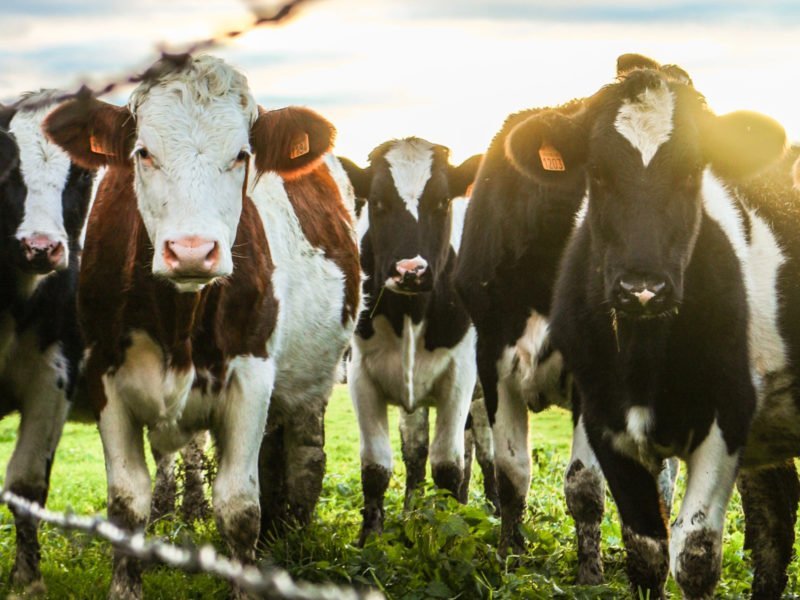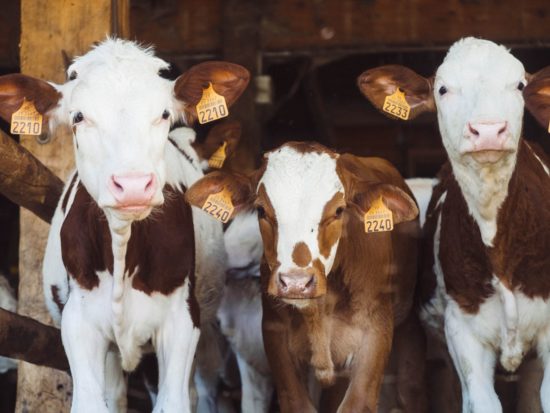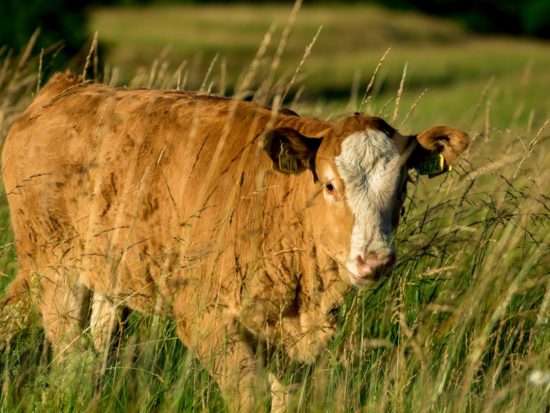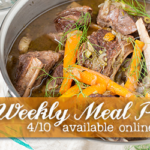You’ve probably noticed that in nearly all of my recipes I write “grass-fed” next to whichever animal protein is in it. This is not just because, but rather due to lots and lots of research.
For many years I didn’t think that it mattered what “style” of meat I purchased. Sure, everyone said that grass-fed was better, but was it really? It just seemed like they were trying to get me to spend more money. I chose to switch over anyway and see what the hype was all about (without doing much research either). Right away I noticed something; the color was different!
And after that first meal, I noticed that the flavor was different, the texture was different, and even the tenderness was different! Which made me even more curious. So I finally did some research, and I will never go back!
There are countless benefits to eating grass-fed meat over grain-fed, so many that it would take up way too much of your time for me to explain them all to you! So I went ahead and picked the points that stood out the most to me. Even so, there’s still a LOT of information here.
In an attempt to help you better navigate through all of this information, I broke it down (by section) in this list for you. If you can, please take the time to read this in full. But if you can’t read it all now, go ahead and skip to the section that best suits your needs and come back later for the rest!
- Grass-Fed Meat and What Makes it Different
- Why Grain Fed Meat Sucks
- The Unethical Treatment of the Cows
- High Doses of Antibiotics
- The Reason Your Meat has Hormones in it
- How Grass-Fed Differs from Grain-Fed
- Top Tips to Cooking With Grass-Fed Meat
- Where Can I Buy Grass-Fed Meat?
- Top Five Favorite Grass-Fed Dishes
Grass-Fed Meat
Grass-fed meat comes from cows who have been fed an entirely grass-based diet compared to the commercially funded and conventional grain fed method. A grain-fed diet is typically made from a base of corn and soy.
As we have learned over the years, both of these products (corn and soy) are ones that we want to steer clear from at all costs… especially soy! We don’t think twice about it when our food eats it, but we should!
You might be thinking, “I have eaten conventional meat products my entire life, how bad could they be?”.
Starting around the mid to late 1940’s, cows began being raised in Concentrated Animal Feeding Operations, or CAFOs for short. CAFOs are designed to optimize the production of our meat in an attempt to keep up with the increased consumption rates, but the methods they use to do this are less than desired.
What makes grain-fed meat so bad? Here are some of the most shocking methods
- Using the grain-feed instead of grass-feeding the cows
- Kept in tight/close quarters that are both unsanitary and inhumane
- Given high doses of antibiotics in an attempt to defeat diseases
- Given hormones to speed their growth in an unnatural manner
Let’s dive a little further into each of these…
Grain-Fed vs. Grass-Fed
The benefits of using a grain fed diet for the cows is decreased cost and increased production. Keep in mind that this benefits the CAFOs only; not the people consuming the product or the cows!
By using a grain fed diet, they get to feed the cows with genetically modified products. As if that wasn’t bad enough though, they often use fillers as well! These fillers have been discovered to include things as insane as gummy worms and marshmallows. Literally taking any measure necessary to decrease the cost of the feed, while still fattening the cows. Which is the second benefit to a CAFO for using a grain-based diet.
By getting a cow fatter, they will reach the mandatory minimum weight needed to be sent off for slaughter sooner. This allows the companies running the CAFOs to produce more meat at a quicker rate.
Tight and Unsanitary Living Quarters
As if fattening the cows wasn’t enough, they also herd them into the tightest quarters possible. Which goes to show how profit is more important than proper treatment.
By fitting as many cows into as small a space as they can, they are able to make more money and send them off to the slaughterhouse quicker.
From an ethics standpoint this is obviously wrong, but how does it affect your physical health?
High Doses of Antibiotics
Since the cows in CAFOs are kept in such tight and unsanitary quarters, they often get very sick.
In order to “save” the rest of the cows from getting sick, the sick ones are pumped with antibiotics in a lame attempt to combat the diseases that the CAFOs themselves created. By having a reactive approach, the disease will still spread, requiring the use of antibiotics for even more cows.
This means that the same cows that were pumped full of antibiotics to kill off a disease created by unsanitary living conditions are being butchered and sold in the same packaging.
Hormone Injections
While the cows are getting fatter from the grain fed diets, they are not necessarily growing faster. In order to combat this, the CAFOs pump cows with hormone injections to speed up their growth.
These hormones end up becoming part of the cow’s molecular structure and when all is said and done, we are eating their meat.
This stresses me out!
Just as you wouldn’t want to eat a corn or soy-based diet, imagine you lived in the same conditions as these cows. You would want out pretty quickly! But you can’t get out. So what happens? You get stressed! Well surprise, surprise… the same happens with cows!
When animals (humans included) are stressed, they have an increase in a stress hormone which is known as cortisol. This increased cortisol becomes part of the meat that we are consuming. And cortisol consumption has been linked to many avoidable health issues!
How does grass-fed differ?
Grass-fed, free-range cows are given the ability to roam and eat a natural diet. Essentially, they are allowed to live the way cows were meant to live. The result of this is properly raised cows that are stress-free.
With that, there is no need for hormones as they are being raised in a natural state, growing at their normal rates of progression. And, being in a free range environment, their quarters are not as confined, which allows for the reduced possibility of diseases. Thus resulting in less use of antibiotics. Instead, antibiotics are only used when needed, rather than as a preventative measure.
An additional aspect that makes grass-fed meat better than grain fed meat is the leanness of the meat. By having less fat (from a proper diet) the resulting meat is leaner!
Another benefit is that grass-fed meat also contains around 5x as many Omega-3 fatty acids as grain fed meat does and twice as much CLA (Conjugated Linoleic Acid)! These compounds are often associated with a reduction in body fat!
You will also find more vitamin A & E in grass-fed meat than you will in grain-fed meat.
Top tips for cooking with Grass-Fed Meat
Due to the leanness of the meat, the cooking time and procedures are changed slightly.
With grass-fed meat you will find that it cooks quicker and there is less shrinkage from fat loss since it is a leaner cut! This results in a thicker and juicier burger EVERY TIME!
Because of the quicker cooking time, people often overcook their grass-fed meat which results in a chewier texture than conventional grain-fed meats.
To combat this, all you need to do is cut back on the cooking time! And in some instances, you could greatly benefit from seasoning or marinading your meat too! When doing so, you’ll get a juicier and tender piece of meat every time!
Where can I buy grass-fed meat?
Some areas have local farms and butchers where they can obtain grass-fed meats! Although more often than not this is not the case.
I don’t have to worry about the effects that grain-fed meat has on my health, or where to buy grass-fed meats locally, thanks to my friends at Thrive Market.
In April, Thrive Market introduced an all-new grass-fed and free-range meat program! Which was made as an addition to their already existing online marketplace of organic, non-GMO, gluten-free, and healthy food options available nation-wide.
When testing their services out, they sent me a box of their new meats to try which included options like; chicken breast, ground beef, and salmon! But when they sent it to me, I was out of town! My family couldn’t resist waiting, so they opened it!
I pretended to open it again for your sake and made an unboxing video!
In this video, you’ll see all of the meat I received, and hear some more information on their amazing new program!
https://www.youtube.com/watch?v=TYYo_gIxP2w&feature=youtu.be
They truly have so many options already available in their marketplace, and this addition is a real game changer!
Not to mention, their products are already 25-50% cheaper on average than typical retail prices as they are solely an online marketplace! And they send it all right to your doorstep in a matter of days!
That discount didn’t seem like enough though, so I got you an extra 25% off your first order and a 30-day free trial when you use my link. Just a simple thank you from me to all of you!
My Favorite Dishes Made with Grass-Fed Meat
Now, as you probably know, I have a protein source in 99% of the things that I cook. So I figured it would be beneficial to you if I chose my 3 favorite dishes made with grass-fed and free-range meats!
- Stir Fry Beef Salad
With stir-fry, you are cooking the beef quickly within the saute. This is perfect for grass-fed meat in order to have a lean, quickly cooked, and tender addition! - Balsamic Grilled Chicken
This recipe is so full of flavor, it would be a shame to use conventional-commercially processed chicken with it! - The Perfect Paleo Burger
With grass-fed beef, the number one use is as ground beef. Due to the leanness of the meat, burgers and other things made from grass-fed beef end up thicker and juicier than any grain-fed beef would! - Crockpot Rump Roast
This rump roast has stood the test of time for a reason! Seven years later and it is still one of the number one viewed recipes on my site. Don’t miss out! - Crockpot Pulled Pork
Nothing beats a tasty and simple pulled pork in my eyes! This one is seasoned with caveman rub and then left to cook in the crockpot! Super simple, yet wildly tasty!
I hope that this information helps you when making an informed decision as to whether or not you make the switch to grass-fed! Or that it reinforces your existing opinion on the topic!!!











Grass fed Beef tastes like something not worth chewing.
if one does not care about flavor and tenderness then grass fed might be good for you.
so you are killing one set of animals instead of another and you call that “moral”
I am fully aware of, and am enthusiastic about the health and environmental advantages of grass fed and finished (important distinction: fed AND finished) beef, but I started noticing the marked drop-off in quality of taste and texture of grass fed beef in my area. I believe this is due to the rising popularity of grass fed/finished beef and the rush to get as much of it to market as possible, in as many stores as possible, which puts producers in a hurry-up situation where quality takes a back seat over just getting the meat out there.
I roughly estimate my red meat consumption to be no more than once a week (if I make chili and have leftovers I’ll be eating for three days, but then I usually won’t have any red meat for a few weeks) so if I’m going to actually enjoy my beef I’m going to have to go back to corn finished for now until producers work out the growing quality gap.
My primary beef (har har) is with the texture – a NY strip steak shouldn’t be THAT lean and THAT chewy. Flavor is definitely richer (it’s that deep, rich minerality – almost gaminess – of the beef that scares off some consumers with wimpy palates, but I love it) if I choose a locally raised variety, but the chewy texture still endures. The flavor of grass fed from big distributors is markedly inferior – this is the beef showing up in the big retail grocery chains, a lot of it imported. There is some serious corner-cutting going on somewhere, because once the big players smell a trend it’s the usual profits over quality that rules the day and soon you have more people saying grass fed beef is lousy, totally unaware that they are being given a hasty, inferior version by a cynical industry chasing a trend for profit.
And I haven’t even gotten started on the ground beef: to date (I’ve been eating grass fed beef for around twelve years now) I have NEVER seen ground grass fed beef (whether produced by a local boutique rancher or a mass-produced import) that stated what cut the meat came from (chuck, sirloin etc). That’s because it’s a random blend of whatever cheaper leftover cuts that couldn’t be sold as individual attractive cuts. That’s a great way to reduce waste for sure, especially if you raise your own cattle, but from a retail consumer standpoint that’s a great way to turn off the public from grass fed beef, which is what finally happened to me I’m sad to say, because as I originally stated, I am fully aware of the health and environmental benefits.
Thank you for this awesome article. Of course, grass-fed meat is far superior to normal meat. That’s only natural. Cows are eating grass and will, therefore, only be kept naturally. I love good meat, it just tastes better.
It is absolutely far superior to grain-fed meat! Though, “normal” meat should be grass-fed rather than grain-fed! Hopefully that thought on what is considered “normal” changes soon!
Jeremy
Team Caveman